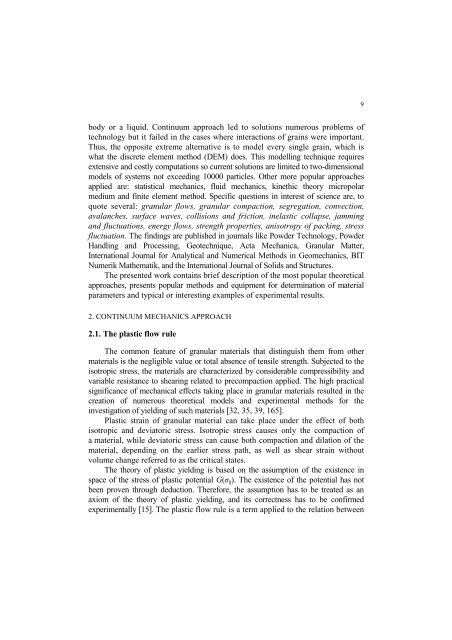Strona 2_redak - Instytut Agrofizyki im. Bohdana DobrzaÅskiego ...
Strona 2_redak - Instytut Agrofizyki im. Bohdana DobrzaÅskiego ...
Strona 2_redak - Instytut Agrofizyki im. Bohdana DobrzaÅskiego ...
Create successful ePaper yourself
Turn your PDF publications into a flip-book with our unique Google optimized e-Paper software.
9<br />
body or a liquid. Continuum approach led to solutions numerous problems of<br />
technology but it failed in the cases where interactions of grains were <strong>im</strong>portant.<br />
Thus, the opposite extreme alternative is to model every single grain, which is<br />
what the discrete element method (DEM) does. This modelling technique requires<br />
extensive and costly computations so current solutions are l<strong>im</strong>ited to two-d<strong>im</strong>ensional<br />
models of systems not exceeding 10000 particles. Other more popular approaches<br />
applied are: statistical mechanics, fluid mechanics, kinethic theory micropolar<br />
medium and finite element method. Specific questions in interest of science are, to<br />
quote several: granular flows, granular compaction, segregation, convection,<br />
avalanches, surface waves, collisions and friction, inelastic collapse, jamming<br />
and fluctuations, energy flows, strength properties, anisotropy of packing, stress<br />
fluctuation. The findings are published in journals like Powder Technology, Powder<br />
Handling and Processing, Geotechnique, Acta Mechanica, Granular Matter,<br />
International Journal for Analytical and Numerical Methods in Geomechanics, BIT<br />
Numerik Mathematik, and the International Journal of Solids and Structures.<br />
The presented work contains brief description of the most popular theoretical<br />
approaches, presents popular methods and equipment for determination of material<br />
parameters and typical or interesting examples of exper<strong>im</strong>ental results.<br />
2. CONTINUUM MECHANICS APPROACH<br />
2.1. The plastic flow rule<br />
The common feature of granular materials that distinguish them from other<br />
materials is the negligible value or total absence of tensile strength. Subjected to the<br />
isotropic stress, the materials are characterized by considerable compressibility and<br />
variable resistance to shearing related to precompaction applied. The high practical<br />
significance of mechanical effects taking place in granular materials resulted in the<br />
creation of numerous theoretical models and exper<strong>im</strong>ental methods for the<br />
investigation of yielding of such materials [32, 35, 39, 165].<br />
Plastic strain of granular material can take place under the effect of both<br />
isotropic and deviatoric stress. Isotropic stress causes only the compaction of<br />
a material, while deviatoric stress can cause both compaction and dilation of the<br />
material, depending on the earlier stress path, as well as shear strain without<br />
volume change referred to as the critical states.<br />
The theory of plastic yielding is based on the assumption of the existence in<br />
space of the stress of plastic potential G(σ ij ). The existence of the potential has not<br />
been proven through deduction. Therefore, the assumption has to be treated as an<br />
axiom of the theory of plastic yielding, and its correctness has to be confirmed<br />
exper<strong>im</strong>entally [15]. The plastic flow rule is a term applied to the relation between
















